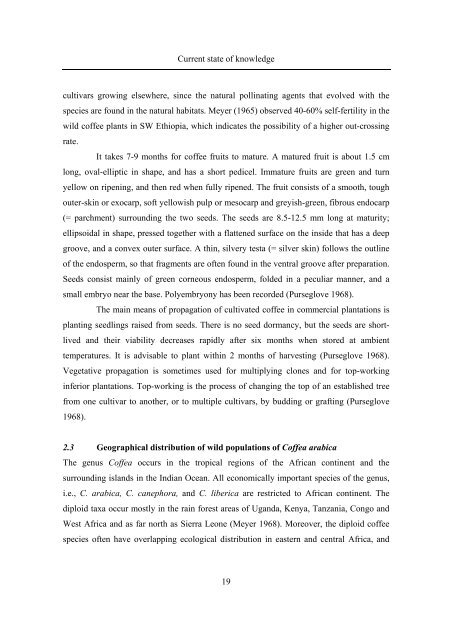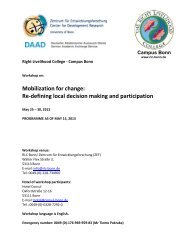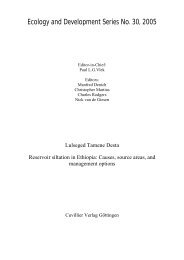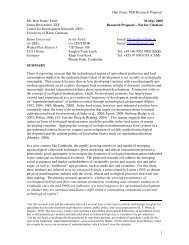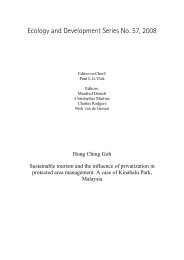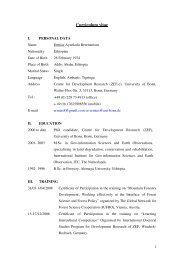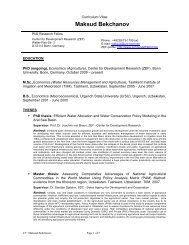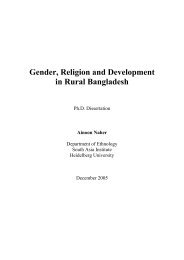Ecology and Development Series No. 10, 2003 - ZEF
Ecology and Development Series No. 10, 2003 - ZEF
Ecology and Development Series No. 10, 2003 - ZEF
- No tags were found...
You also want an ePaper? Increase the reach of your titles
YUMPU automatically turns print PDFs into web optimized ePapers that Google loves.
Current state of knowledgecultivars growing elsewhere, since the natural pollinating agents that evolved with thespecies are found in the natural habitats. Meyer (1965) observed 40-60% self-fertility in thewild coffee plants in SW Ethiopia, which indicates the possibility of a higher out-crossingrate.It takes 7-9 months for coffee fruits to mature. A matured fruit is about 1.5 cmlong, oval-elliptic in shape, <strong>and</strong> has a short pedicel. Immature fruits are green <strong>and</strong> turnyellow on ripening, <strong>and</strong> then red when fully ripened. The fruit consists of a smooth, toughouter-skin or exocarp, soft yellowish pulp or mesocarp <strong>and</strong> greyish-green, fibrous endocarp(= parchment) surrounding the two seeds. The seeds are 8.5-12.5 mm long at maturity;ellipsoidal in shape, pressed together with a flattened surface on the inside that has a deepgroove, <strong>and</strong> a convex outer surface. A thin, silvery testa (= silver skin) follows the outlineof the endosperm, so that fragments are often found in the ventral groove after preparation.Seeds consist mainly of green corneous endosperm, folded in a peculiar manner, <strong>and</strong> asmall embryo near the base. Polyembryony has been recorded (Purseglove 1968).The main means of propagation of cultivated coffee in commercial plantations isplanting seedlings raised from seeds. There is no seed dormancy, but the seeds are shortlived<strong>and</strong> their viability decreases rapidly after six months when stored at ambienttemperatures. It is advisable to plant within 2 months of harvesting (Purseglove 1968).Vegetative propagation is sometimes used for multiplying clones <strong>and</strong> for top-workinginferior plantations. Top-working is the process of changing the top of an established treefrom one cultivar to another, or to multiple cultivars, by budding or grafting (Purseglove1968).2.3 Geographical distribution of wild populations of Coffea arabicaThe genus Coffea occurs in the tropical regions of the African continent <strong>and</strong> thesurrounding isl<strong>and</strong>s in the Indian Ocean. All economically important species of the genus,i.e., C. arabica, C. canephora, <strong>and</strong> C. liberica are restricted to African continent. Thediploid taxa occur mostly in the rain forest areas of Ug<strong>and</strong>a, Kenya, Tanzania, Congo <strong>and</strong>West Africa <strong>and</strong> as far north as Sierra Leone (Meyer 1968). Moreover, the diploid coffeespecies often have overlapping ecological distribution in eastern <strong>and</strong> central Africa, <strong>and</strong>19


